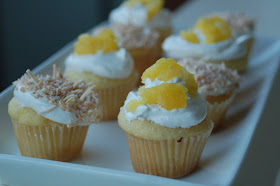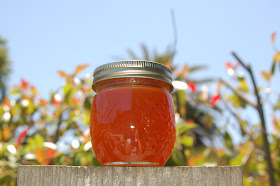
We recently celebrated a birthday with a luau. Grandma Betty turned…oops, I’ll never tell…and she loves Hawaii, so my sister-in-law wanted to celebrate appropriately with a big surprise party. We concocted the themed menu of kahlua pork, steamed rice, macaroni salad and tropical fruit salad. Perfect for what would turn out to be a scorching 105-degree day.
For dessert, I offered up some options: trifle (Betty’s fave), pina colada cupcakes or mai tai cupcakes. While the debate raged on which to do, I set out to test recipes. Brilliant Daughter and I started with individual trifles made with multiple layers of pound cake, berries, my homemade berry-cassis sauce, and Bird’s custard, all topped off by whipped cream. It just so happened Betty was here for a visit and I lied, telling her that I was researching trifle recipes, and got her to taste test. She wasn’t wholly impressed, partly because I had neglected to brush the pound cake with brandy. Oops.
Next we moved on to the pina colada cupcakes. To simplify things, I started with a box mix. First I made the standard cupcake, adding drained, crushed pineapple to half the batter and raw grated coconut to the other half. The pineapple cupcakes really didn’t rise and looked a bit forlorn. I think it was the extra liquid in the pineapple that caused this little problem. They didn’t taste bad, but the perfectionist in me wasn’t satisfied The coconut cupcakes just didn’t taste coconutty enough. So I tried again.
I made a second batch using coconut milk in place of the water and sweetened shredded coconut. This I topped with a cooked meringue frosting, which I love, but realized would be just too time consuming given everything else we had to do for the party. (This is the version pictured at top.)
So on to #3. To this batch I added a box of coconut crème pudding mix (I had no idea that Jello-O makes such diverse flavors in pudding, as I never buy it) and the sweetened shredded coconut. I topped these off with a cream cheese/buttercream frosting with pineapple bits. The frosting was an instant hit. I knew it was the right one to use. But the cupcake could be better.
At this point, the decision has been made to go with the pina colada cupcakes, so I needed to step it up. On a leisurely walk with Mr B and friend Larry, I mentioned my dilemma. Suggestions popped left and right and I was again inspired. (Thank you, boys!) Number 4 turned out to be the winner. The addition of Finest Call Pina Colada mix, half box of pudding, and shredded coconut made for a great flavor, moist cake, and perfect foil for the cream cheese/buttercream frosting.
As a topper I had made homemade candied pineapple. This was purely by chance, mind you. I was experimenting with candied citrus, after seeing this recipe on the Brownie Points blog. I had some lemons and oranges I wanted to use, and since I had leftover pineapple, I thought I would try that, too. The result is an almost melt-in-your-mouth piece of pineapple. Sweet, but still flavorful, and shaken with sugar, the perfect little decoration for the cupcake.
So, now that I have done all the work finding the right recipe, I suggest you give them a whirl. Timewise, it is a small investment for the reward. Five minutes to make the cupcakes, 20-25 to bake, 5 minutes on the frosting and a few more to frost. Top them off with piece of fresh or candied pineapple, maraschino cherry, toasted coconut, or one of those cute little paper umbrellas and watch the kudos come your way.
CUPCAKES
1 box Betty Crocker yellow cake mix
1 1/4 cup Finest Call Pina Colada Mix
1/2 box instant coconut crème Jell-O pudding mix
1/2 cup vegetable oil
4 eggs
Beat the cake mix with the dry pudding, pina colada mix and oil. Add eggs, one at a time, mixing well after each. Beat fro 2 additional minutes on medium-high. Scoop into paper lined cupcake molds, filling only 1/2 full. Bake 20-25 minutes at 350 degrees, until cake tests done with toothpick. Let cool and frost.
FROSTING:
8 oz. cream cheese, at room temperature
1 1/2 sticks unsalted butter, at room temperature
1 pound powdered sugar, sifted
3/4 cup crushed pineapple, drained and squeezed dry
Optional: Candied pineapple or toasted coconut for decoration.
Whip cream cheese and butter with hand or stand mixer until well incorporated, at least one minute. Add in powdered sugar slowly on low speed, so the sugar dust doesn’t fly all over. Once all has been added, turn on high and whip for 2 minutes. Add the drained and dried pineapple, breaking up with your fingers. Mix on medium speed until incorporated. Pipe or spread onto cupcakes and top with candied pineapple or toasted coconut.
























